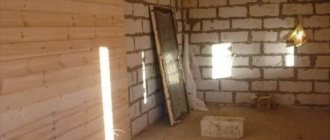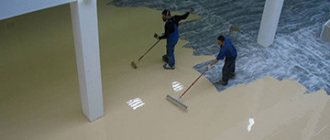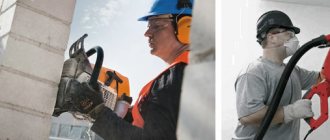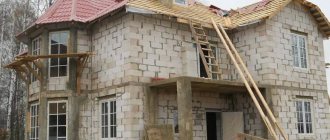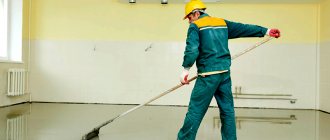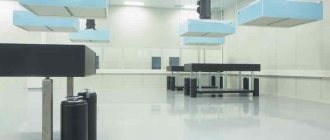Finishing work on aerated concrete is carried out not so much to impart decorative qualities, but to protect the material from moisture. At the same time, surface pretreatment often seems like a waste of time and materials.
Painting work on aerated concrete is carried out to add greater aesthetic value and to protect it from moisture. In different situations, priority is given to either the decorative or protective component. At the same time, applying paint directly to aerated blocks is done extremely rarely, only in completely inconspicuous areas of the walls. Painted aerated concrete looks too unsightly; seams or small flaws in the blocks caused by laying stand out. Most often, a preparatory plaster layer is applied, which provides an even and smooth surface for the finishing coat. However, in some cases, applying plaster seems like an excessive measure, especially if the finishing is done only for a protective purpose and has no decorative significance. In such cases, the easiest way is to paint aerated concrete (gas silicate blocks) without preparation, or to perform a minimum of primary finishing - putty on the wall, eliminating noticeable potholes and closing the seams. At the same time, many novice finishers wonder whether it is possible to paint walls without first plastering the aerated concrete blocks. The issue is quite complex and requires detailed coverage.
Classification of facade paints based on foam concrete
For the outer surface of the walls of a foam block house, water-dispersion based façade paints with various fillers are used. Depending on the porosity of the blocks and the quality of the masonry, you can choose smooth, structural or textured compositions, allowing you to obtain visually different coatings.
The main difference between façade paint for foam blocks and materials for other surfaces is vapor permeability , similar to that of foam concrete. Thanks to this, the walls do not lose their ability to breathe.
With this method of finishing the facade, paints of the following categories are most often used:
- Silicate with liquid potassium glass - allow you to obtain a durable coating that is resistant to atmospheric influences and mechanical damage. During the painting process, a chemical reaction occurs, the result of which is the overall crystal lattice of the coating and the wall material itself.
- Silicone - silicone resins are used in production, which have good water-repellent properties. At the same time, they did not lose vapor permeability. They are considered one of the best options for protecting porous concrete from moisture.
- Rubber - made with the addition of latex, which forms an elastic and durable surface film. They hide small defects well, are opaque, resistant to ultraviolet radiation, and do not fade in the sun.
The above categories of paints allow you to paint foam blocks without plaster.
It is also possible to use acrylic-based materials, but when painting without plastering they will be less effective. Therefore, it is worth choosing these options; this will allow you to obtain durable facade coatings. And the required shade will be provided by color pigments added to the base composition.
Finishing materials for aerated concrete
Different materials are required for the interior and exterior decoration of aerated concrete houses. However, they must match each other in terms of permeability to water vapor. This is an important requirement to ensure durability and reliability of protection. If impermeable paint or plaster is chosen for exterior finishing, the inner layers of aerated concrete will begin to become wet. Water bubbles will appear and the finish will begin to sag and peel off from the base. For interior decoration, on the contrary, the least permeable materials are needed, otherwise the finishing layers will get wet. Plaster will absorb water vapor more actively than a wall made of aerated concrete, which will cause dampness, mold and other undesirable manifestations. Therefore, materials should be selected taking into account the location of application and operating conditions.
In addition, experts recommend using continuous plastering for interior decoration using mineral plaster (or a regular sand-cement composition). This is done to strengthen the surface, to enhance the strength of the surface layer. This procedure allows you to increase the strength of the installation of dowels or other fasteners when hanging furniture or household appliances, heating boilers or other appliances.
What influences the choice of facade paint for foam blocks
When choosing paints and varnishes, it is necessary to take into account the characteristics of the blocks and the quality of the masonry.
If you liked the way your neighbor's house looked after painting, it doesn't mean your house will look the same after applying the same paint. It has been repeatedly tested: the same façade paint for foam blocks will look different on different surfaces .
When painting foam concrete walls, consider the following factors.
- If the technology of jointing masonry was used, it is worth choosing smooth silicate, silicone and combined compositions on a water-based emulsion. Moreover, this option is suitable for blocks with both straight and beveled edges at an angle of 45°. Embroidered seams visually fade into the background, the painted surface acquires volume and relief. Please note that the use of conventional structural paints and varnishes will remove this effect, which is why the appearance of the wall will look less advantageous.
- For work on plaster or simply smooth wall surfaces, structural paints with coarse fillers are more suitable. In this case, the visual volume of the coating is obtained through multi-layer painting, as a result the surface will look more impressive.
The choice of paints is huge, and you can experiment with other materials, but professionals, in most cases, take exactly this approach to choosing facade paint for foam blocks.
Choosing the right mixture – Will it win or Ceresit?
Products made from cellular concrete are characterized by selective adhesion to compounds that protect the walls of residential buildings from moisture. For this reason, not all traditional plaster solutions can be used to treat foam concrete surfaces. In particular, there is no point in using well-known lime and cement-sand mixtures. They simply will not stick to foam blocks. Let's move on. Cellular concrete products have a fairly high vapor permeability rate. Because of this, when a protective composition is applied to the blocks, moisture will begin to accumulate underneath it (the plaster mortar will not allow steam to pass through). It is clear that condensation will have a detrimental effect on the wall surface.
This problem is solved by selecting a plaster that will be vapor permeable. Then the walls will be able to breathe under the moisture-proof layer. How do experts recommend plastering foam concrete surfaces? It is best to do such work with your own hands, using factory mixtures sold in construction stores. These include the following types of plaster:
- TM-22 will win - a composition based on lime and cement with special additives that increase the adhesion of the protective solution;
- Ceresit ST 24 is a universal mixture that is especially popular among home craftsmen;
- ST 137 – plaster with mineral components;
- ST 29 is a special repair composition designed to protect foam blocks from moisture;
- Vertical GB is a new plaster mortar for concrete surfaces with a cellular structure;
- ST 174 – siloxane-silicate mixture.
All of these formulations are easy to use. With their help, you can finish foam concrete walls with your own hands in a short time, without worrying about the quality of the resulting protective layer. But the cost of such ready-made mixtures may not appeal to thrifty home craftsmen.
We can advise them to prepare the plaster composition themselves. It is made from 0.2 parts lime paste, 1 part cement (it is advisable to take material marked M400) and 3 parts building sand. It is better to make lime dough yourself rather than purchase ready-made ones. Just add water to slaked lime and stir this mixture until it becomes similar in consistency to homemade sour cream.
Popular paint brands
Paint and varnish products in this category are produced by various brands. Paints from leading manufacturers are largely similar in price and performance properties. Therefore, the choice most often depends on what material the painter is used to working with.
Among all the rubber paints, “Super Decor”, produced under the Rubber trademark, stands out. Manufacturers provide a 15-year warranty on the coating. It completely insulates the surface of foam concrete from moisture, is highly elastic, and is capable of bridging and sealing minor cracks in the base.
The structural PROFITEC Porenbeton-Beschichtung P 790, which is produced by the German brand MEFFERT AG FARBWERKE, is in demand. It has proven itself well in interior and exterior decoration. Forms a surface similar in structure to fine-grained plaster. Resistant to abrasion and mechanical damage, has water-repellent properties.
Textured facade paint for Anserglob foam blocks is in demand. It is characterized by increased density. It is applied to the surface of foam concrete with a spatula, the surface is formed using a relief roller. It has good adhesive properties, provides reliable protection, and can be tinted in any chosen color using coloring pigments.
These are not the only possible options, but they are still worth paying attention to. The price corresponds to the quality.
Exterior wall painting technology
The easiest way to paint is foam block walls that have been pre-plastered and leveled with putty. This surface is already protected from moisture, and adhesion to paints and varnishes is also improved. In this case, the use of cheaper compounds is allowed.
To get the best result, paint as follows.
- We clean the wall surface from dust and dirt. If there is an oily sheen anywhere, we destroy it with sandpaper.
- We treat the wall in 2-3 layers, using a primer for deep penetration foam blocks, which additionally strengthens the plaster layer, increasing adhesion.
- Only after the primer has completely dried do we begin painting the foam blocks. Depending on the class of paint, our tool will be a spatula, roller or brush. We paint without changing direction; if the first layer is laid vertically, the second must be applied with horizontal movements.
It's great that no additional processing is required. During the polymerization and drying process, a surface is formed with all the performance properties declared by the manufacturer. Reliable and beautiful.
If it is necessary to change the color, tinting is done using dry or liquid pigments suitable for the type of paint and varnish materials used.
Features of coloring
Having decided how to paint penoplex without plaster, you need to understand the painting technology. The choice of method depends on the location of the foam material and the purpose of use.
Preparing the wall
Penoplex for insulation is produced in the form of small slabs. To adjust the size, the material is cut with a construction knife. The parts are glued to the facade using a special compound (“Atlas”, “Titan”). The cracks are sealed with acrylic-based sealant.
The plaster is diluted according to the instructions. The first layer of putty is applied at a thickness of 5 mm. A reinforcing mesh is sunk into the surface, smoothing out irregularities with a spatula. After drying, sanding is carried out to remove defects. The wall is impregnated with primer. The second tier of finishing is the finishing one. After hardening, the facade is cleaned with a machine or sandpaper, achieving smoothness.
If you are working with decorative elements, then the polystyrene parts need to be washed. Remove dust and debris from the foam material with a damp cloth. Before applying enamel, the surface must be primed. Apply the suspension with a brush or roller, being careful not to stain the walls, and dry thoroughly.
Painting foam blocks without plaster
If the goal is to build a house as economically as possible, the question arises: is it possible to paint foam blocks without plaster? The answer is yes. However, in this case it will take more time to prepare the wall. After all, the paintwork will highlight any defects in the masonry.
Therefore, if we want to paint foam blocks without plaster, we will have to carry out the following work.
- We clean the base from dust, dirt, and oily stains.
- It is very advisable to know in advance that facade paint without plaster will be used for foam blocks. Then, even at the laying stage, you need to do a beautiful jointing. If for some reason this was not done, it will have to be done now. We use everything we can, even the grinder.
- We repair chips and other damage to blocks.
- We carry out primary priming of foam blocks with deep penetration compounds.
- We seal the cracks with plaster mixtures or façade putty.
- We process the wall twice, again using a primer for foam blocks.
Next, painting of foam blocks without plaster is carried out using technology that is used for plastered surfaces. The best result can only be obtained by using structural or textured facade paint.
I recommend watching the five-minute video below. Its value lies in the fact that the people who filmed it were painting the house for the first time. And it turned out well. They told us what, how, why, and then showed everything. Their house is made of aerated concrete, but everything also applies to a foam concrete house.
conclusions
On the one hand, the foam concrete will absorb moisture from the outside, from which it needs to be protected. On the other hand, it is necessary to preserve its vapor-permeable properties. Because of this paradox, painting walls requires utmost attention when choosing materials and at the surface preparation stage.
Only suitable façade paint for foam blocks plus careful preparation of the walls before painting. Any mistake will reduce the service life of the coating.
It is better to use silicone, silicate or rubber compounds that are designed to work on porous substrates.
Despite the complexity of the process, you can paint foam blocks yourself, both plastered and without plaster.
How to paint aerated concrete blocks?
To choose the right paint for aerated concrete, we offer a simple algorithm:
When choosing what to paint aerated concrete on the outside, you also need to take into account the air temperature (not all paints and varnishes can be used at temperatures below +10°C), consumption and cost of painting 1 m², and drying time.
Another interesting way to finish a foam block is puttying. The plastered surface is treated with special compounds to make it more even. Most often, mixtures have a white color, which is convenient to apply under paint - it will not change or show through the shade of the base.
Sometimes thrifty owners do without plastering and immediately use putty. This option is acceptable for temporary covering of the facade - without the main leveling layer, the appearance of the house quickly loses its original appearance. A thin layer of putty is applied to the main wall, then paint.
Modern designers and craftsmen manage to kill two birds with one stone - when mixing the putty mixture, they add a construction color to the solution. This method is rare, but it does happen:
- The substance does not change the characteristics of the material and does not affect its solubility;
- The use of white plaster with color allows you to reduce work time by combining two stages.
True, there are several nuances of the technique:
- The solution must be thoroughly mixed. For the process it is necessary to use a construction mixer.
- To cover a large area, careful selection of shade is required: the solution is prepared in small batches, each shade must match the previous one so that there are no color transitions.
Puttying with a white or tinted mixture without laying a plaster layer or immediately painting the foam block is only suitable for creating a temporary external appearance of the house. Over time, the coating wears off, washes off and is absorbed. After 3-4 years, it is necessary to install a new facing layer.
